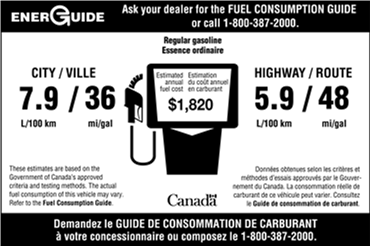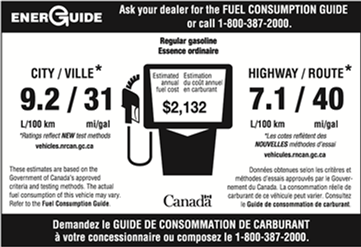Here we go, ready for mass confusion,
NOTE: these links are for Canada... not sure on the US changes if any. The MPG figures shown will be for imperial gallons, not US gals.
Apparently, for 2015 the testing and published sticker fuel economy standard is changing,, So, there may be a reduction in fuel efficiency numbers for 2015 though no actual change from 2014...
https://www.nrcan.gc.ca/energy/effic...ks/buying/7491
"New Test Methods for Model Year 2015
Starting with 2015 model year vehicles, manufacturers will use an improved testing procedure to determine the fuel consumption ratings of new light-duty vehicles. The Government of Canada approved new test methods better approximate typical driving conditions and styles by adjusting city and highway ratings to account for air conditioner usage, cold temperature operation and driving at higher speeds with more rapid acceleration and braking. These new test methods (5-cycle testing) result in higher fuel consumption ratings that are more representative of a vehicles on-road fuel consumption compared to the current (2-cycle testing) methodology."
Example:
2014 model vehicle
![]()
same vehicle in 2015
![]()
NOTE: these links are for Canada... not sure on the US changes if any. The MPG figures shown will be for imperial gallons, not US gals.
Apparently, for 2015 the testing and published sticker fuel economy standard is changing,, So, there may be a reduction in fuel efficiency numbers for 2015 though no actual change from 2014...
https://www.nrcan.gc.ca/energy/effic...ks/buying/7491
"New Test Methods for Model Year 2015
Starting with 2015 model year vehicles, manufacturers will use an improved testing procedure to determine the fuel consumption ratings of new light-duty vehicles. The Government of Canada approved new test methods better approximate typical driving conditions and styles by adjusting city and highway ratings to account for air conditioner usage, cold temperature operation and driving at higher speeds with more rapid acceleration and braking. These new test methods (5-cycle testing) result in higher fuel consumption ratings that are more representative of a vehicles on-road fuel consumption compared to the current (2-cycle testing) methodology."
Example:
2014 model vehicle

same vehicle in 2015
